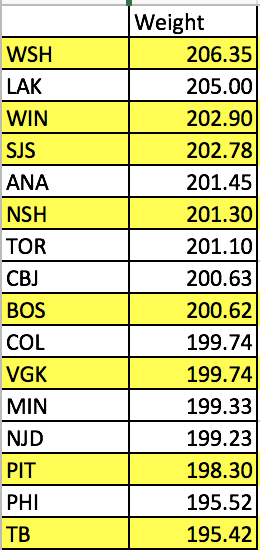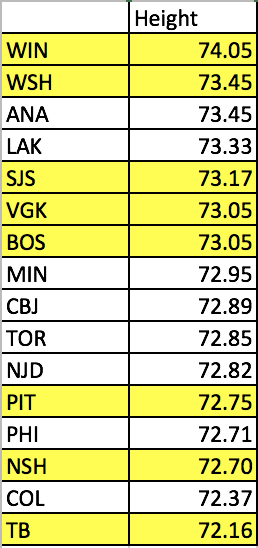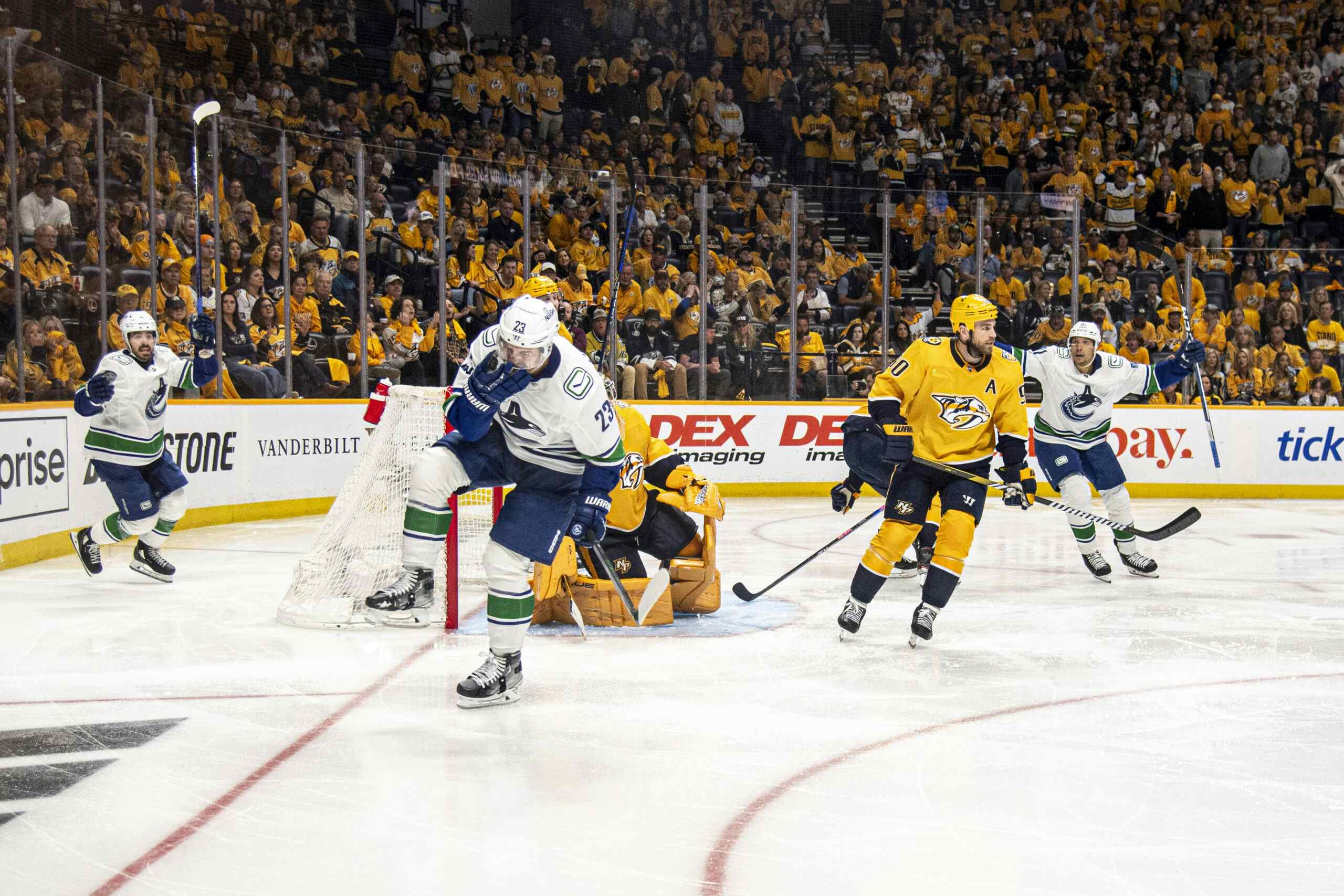Does size matter in the playoffs?

5 years ago
Are the days of the big, bad teams that are bullying and bruising their way through the Stanley Cup Playoffs a thing of the past?
With the post-season already in its second round, there have been many discussions surrounding what’s been the driving force in getting the final eight teams to where they are. As one might expect, it’s one of hockey’s most timeless narratives that has bubbled to the surface, with many suggesting that big, physical and strong teams rise to the top in the second season.
The playoffs are a different animal, and to find success there, one must have a gritty, tough team, or so they say.
Obviously here in Vancouver, it’s a topic of discussion because of the big bad Bruins physically defeating the Canucks en route to a Stanley Cup.
With that, I wanted to see how the playoff teams stacked up against each other and who held the size advantages. Was there a trend among teams that advanced?
All the data used below is from Natural Stat Trick and includes any skater that dressed in at least one playoff game. (I’ve included average age as well)
| AVG AGE | AVG Height (in) | AVG Weight (lbs) | |
| ANA | 28.55 | 73.45 | 201.45 |
| BOS | 27.76 | 73.05 | 200.62 |
| CBJ | 25.74 | 72.89 | 200.63 |
| COL | 25.05 | 72.37 | 199.74 |
| LAK | 27.90 | 73.33 | 205.00 |
| MIN | 27.48 | 72.95 | 199.33 |
| NJD | 26.82 | 72.82 | 199.23 |
| NSH | 27.40 | 72.70 | 201.30 |
| PHI | 26.24 | 72.71 | 195.52 |
| PIT | 26.95 | 72.75 | 198.30 |
| SJS | 27.78 | 73.17 | 202.78 |
| TB | 27.42 | 72.16 | 195.42 |
| TOR | 27.40 | 72.85 | 201.10 |
| VGK | 26.79 | 73.05 | 199.74 |
| WIN | 26.14 | 74.05 | 202.90 |
| WSH | 27.30 | 73.45 | 206.35 |
In the Pacific division, the perception is that Anaheim and Los Angeles are big bruising teams that use their size to defeat their opponent.
| Height | Weight | |
| LAK | 73.33 | 205.00 |
| VGK | 73.05 | 199.74 |
| ———– | ———– | ———– |
| ANA | 73.45 | 201.45 |
| SJS | 73.17 | 202.78 |
When looking at those series, the southern California teams had the advantage in three of the circumstances. Los Angeles and Anaheim combined for zero wins and scored just eight goals. San Jose had eight goals in their Game 3 against Anaheim alone.
In round two, Vegas is smaller in height and weight when compared to San Jose. They looked okay on Thursday night.
Over in the Central Division, the bigger teams prevailed:
| Height | Weight | |
| NSH | 72.70 | 201.30 |
| COL | 72.37 | 199.74 |
| ———– | ———– | ———– |
| WIN | 74.05 | 202.90 |
| MIN | 72.95 | 199.33 |
It’s fair to say that Winnipeg is known as a rugged, physical team but their lineup is also replete with skill from top to bottom. The players that are really boosting their size are Tyler Myers, Dustin Byfuglien, and Blake Wheeler (just to name a few).
Nashville being the larger team of the first round matchup isn’t surprising, as Colorado isn’t a huge team. But now Nashville gives up the size advantage to Winnipeg in both categories.
In the Eastern Conference, it was a mixed bag.
| Height | Weight | |
| TB | 72.16 | 195.42 |
| NJD | 72.82 | 199.23 |
| ———- | ———– | ———– |
| BOS | 73.05 | 200.62 |
| TOR | 72.85 | 201.10 |
New Jersey had the height and weight advantages and got run out of the playoffs quickly by the Lightning. Tampa Bay is the smallest team to qualify for the playoffs in both categories.
Toronto surprisingly had the weight advantage on the Bruins with the team from Beantown having a slight edge in the height category. Really, the series came down to the final 20 minutes of Game 7 with the taller team beating the heavier team.
Lastly, in the Metropolitan division, the Caps and Pens meet in the second round for the third straight year. There was a little more of a concrete trend in those first-round matchups:
| Height | Weight | |
| CBJ | 72.89 | 200.63 |
| WSH | 73.45 | 206.35 |
| ———– | ———– | ———– |
| PHI | 72.71 | 195.52 |
| PIT | 72.75 | 198.30 |
I was a little surprised to see Washington as the heaviest team to make the playoffs, but once I compiled all the data, it became clear that their bottom six players all have some physicality and size to them.
The battle of Pennsylvania also provided a bit of a surprise at first glance. Philadelphia has the long-held perception as the big, bad Flyers who will run you out of the building. To some degree, they do still play that way with a few of their players are not afraid to take the body. The Penguins had the size advantage in both categories, but it is important to add that Pittsburgh was ranked 14th in average weight and Philadelphia was 15th. So, any matchup other than Tampa Bay would’ve meant that they were giving up the advantage.
With that, here are the 16 playoff teams in order of average weight. Highlighted in yellow are the teams that advanced:

Now sorted by weight:

So, what’s the take away here?
Let’s say that Tampa Bay, Pittsburgh, Vegas, and Nashville all advance to the second round — that would mean the 16th, 14th, 11th and 6th tallest teams to make the playoffs are the final four teams. Looking at their heights, that would mean 16th, 14th, 12th, and 6th tallest teams that made the playoffs have made it to the Semi-Finals.
On the other side, if Boston, San Jose, Washington, and Winnipeg make the Conference finals, we have the 1st, 3rd, 4th, and 9th heaviest teams there and the 1st, 2nd, 5th and 7th tallest teams.
Basically, the outcome of a couple of series can change the narrative and however it fits into peoples mindsets.
Perception can be a funny thing. Winnipeg is one of the larger teams, but it’s fair to suggest they aren’t some plodding group of bruisers who will use those size advantages to punish their opponents; they are an extremely skilled bunch. One could say the same about Nashville.
What really stands out to me when watching these playoffs is the pace. All these teams can skate quickly, move the puck fast, and turn the play the other way.
So, if the thought is that teams need to be playing big boy hockey to be successful in the playoffs, perhaps it’s time to realize that to some degree size doesn’t matter. It doesn’t mean that you should ignore it and have a bunch of 5-foot-6 players running up and down the ice, but it does shed light into the fact that sometimes the matchup will play a bigger role as we clearly saw with the Southern California teams.
The Stanley Cup Playoffs takes a wide range of things to make it all the way to the finals which include depth, skill and some luck. It isn’t merely about grit or size. The perception of what teams need will change based on whoever takes home the big prize this year, but I think focusing on speed and skill is the worthwhile path to follow.





